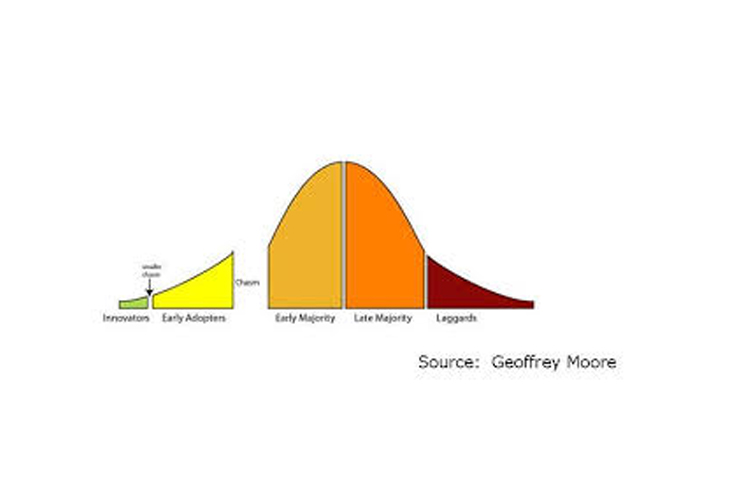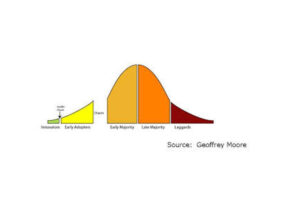Crossing the Chasm – Technology Adoption Life cycle – relevance and significance in today’s changing market space
In this blog, I am going to attempt to apply technology adoption curve as explained in the book Crossing the Chasm by Geoffrey Moore, to today’s products and technology market scenario. The views I express in this blog are my personal opinions, and are not a line on the rock. By that I mean, that people may have different opinions and hence my inferences and analysis are not universal but subjective, might not be the ultimate truth, but surely worth giving a thought.
Since the beginning of my career I have always contributed to promoting, popularizing and helping the industry in India to adopt the latest technologies.Then may it be CNC Machines and CNC retrofit systems in the early 80s; DC variable speed drives, servo motors and PLCs in the mid-80s; to CAD/CAM/CAE and simulation tools and technologies in the early 90s. I believe, a company must adapt and adopt technologies corresponding to the changes occurring or being anticipated in the market to stay resilient and relevant in the changing market conditions.
During this period, I have always referred to and considered this book, ‘Crossing the Chasm’ by Geoffrey Moore as my Bible. The technology adoption lifecycle that he has so eloquently studied and explained in this book holds relevance even today. For those of you, who haven’t read the book, I will give a very short anda brief description about the technology curve before I express my views on how it is applicable in today’s market scenario.
Geoffrey Moore explains 5 key categories of customersin the Technology Adoption life cycle:
- Innovators: they are proactive users of new technologies, willing to experiment, and don’t mind taking risks. They like to see for themselves, how the new technology can add value to their area of work. Classic examples of companies in this category are – research oriented companies or scientists working on some break through innovation or studies. These people or companies want to use technology for further invention or discovery.
- Early Adopters: they are technology enthusiasts. They are passionate about technology and love getting a ‘hands on’ experience of working on new technology. They are excited about new knowledge and new technology, and are not averse to taking risks or making investments in that direction. These people or companies are pragmatic. They know that if they understand and make best use of technology earlier than the competition, then they can reap higher, greater and better benefits out of it and be a leader or a trend setter in their area of work. E.g. of this are Banks who first provided internet banking facility to the customers before the competition; Dell first to offer online purchase option bypassing the physical stores which was a convention back then, and is even today to a certain extent.
- Early Majority: majority of the companies and people fall into this category. Companies in this category will adopt a technology once it is proven, is complete, pricing is comparable to other competitive and similar products or technology, and is offered by a Market leader. These companies are more calculative, will go for the technology once it meets their benchmark and other support and service requirements. They will not be the trend setters, but usually the earlier trend followers. They will see which way the wind is blowing, and will accordingly align their sail earlier, quicker and faster than the rest. These companies are quick in bringing change in their system, are adoptive, flexible and they know they are not the innovators and if they are to derive benefits out of the technology, they need to sense and anticipate the changing trend and act fast accordingly. E.g. majority of the Mobile hand set companies, who were among the first to introduce touch screen and smart phones after Apple.
- Late Majority: these companies or people are more conservative in their approach. They change and adopt technology only when they are compelled by the market conditions to bring about the necessary change in their processes and systems. They will react late, they are usually slow and inflexible and way too process oriented or may be highly bureaucratic to be agile and swift enough. They will be the ones getting the balance of the share in the market that is left behind by the companies in the earlier three categories. E.g. New entrants in the mobile handset industry having nothing new to offer, yet manage to make decent sale maybe because of costs advantage alone.
- Laggards: these companies are the most hesitant and apprehensive to change. They love the convention and are reluctant to introducing anything new in their processes or system. They keep following their north star, not realizing that the earth’s tilted axis and rotation and revolution around the sun, causes the directions to change and they might infact be heading a wrong way in the name of consistency and convention. These companies usually perish. They might be the leaders in the initial hay days of their business, but with time, they lose way and are forgotten. E.g Blackberry with time has become a laggard, not being able to cope up with change.
The diagram above shows thin cracks between all these phases, and a major crack or a crevice after Early adopters and before Early majority cycle phase. It is because; some of the products or technologies do not get through these phases and make it to the next stage. The most difficult phase for a product or company to be successful is Crossing the Chasm on to the third stage i.e. to EarlyMajority from the Early Adopters. This is toughest. Once the companies cross this chasm, they have attainedgreat success. That is where the title of the book “Crossing the Chasm” comes from. There are very few companies who drop off in the cracks or fall behind after having Crossed the Chasm. They might lose speed or grip over market if they fail to continue the consistent pace of innovation. If the company gets complacent or underestimates competition, or fails to anticipate or envision the change in the technology or the market space, they might fall behind. One classic example of this is Blackberry. They were the torch bearers, the leaders in the enterprise mobile handset market space, but they soon started losing to Competition from Apple which has been a highly innovative company known for producing breakthrough innovations that change the rule and field of play.
There are so many products which became popular with the Innovators and the Early Adopters, but cannot make it to the Early Majority stage. Some of the best examples of these are – Pagers, Blu Ray technology, Disc Man, MP3 players etc. The reasons for them not able to Cross the Chasm could be plenty. The reason pagers could not pick up, was lack in time. Just when they were getting popular, a mobile handset was invented and pager became obsolete. The augmented frequency of new product innovations, is giving the products less time to cross the chasm and become successful. Similar thing happened with the disc man, just when they were becoming popular; Apple came out with iPod which became the new sensation and the object of desire for everyone.
In todays’ fast changing world One of the common practices companies adopt to make their product popular and get through to Early Majority stage by crossing the Chasm is, offer the product at highly discounted or subsidized price, or maybe even free. Once it becomes popular, they start levying some sort of charges. There are so many contemporary prevalent examples of this such as Whats App, Facebook and Skype– they were offered free to the users. So now they have Crossed the Chasm from Early Adopters to the Early Majority stage, and in the case of Facebook, they may have gone up to even the Late Majority stage. Skype has however started charging for their VOIP services. It will be interesting to see, how they combat the competition from Whats app calling service which is free.
Today you can witness and experience a huge etail boom in India. With sites like Snapdeal, amazon.in, Flipkart providing products at extensively subsidized prices, consumers are having a big advantage in shopping online. They get their desired products at lesser price, plus are delivered to them at their door steps. It’s a big boon for the consumers. The etail giants are incurring substantial losses in this process but have made a way for themselves to Cross the Chasm to reach Early Majority. They are in the transition phase in India at this moment, making their way to the Early Majority. Whether they will be able to sustain this business model and start making profit for themselves, only time will tell. But at this point in time, they are investing huge in creating attractive and appealing Marketing campaigns through advertisements, special offers, ‘big day sales’ and what not, to Cross the chasm.
Another approach that companies adopt to Cross the Chasm is they introduce the product in the niche market segment initially. Once it becomes successful there, they roll it out to the larger geography or industry. Once they are proven in the niche segment, they can make this their reference site and spread the scheme to the entire canvas. Because Early Majority category companies or people look for a proven technology or product with comparable or competitive price from an established company, this makes for an ideal strategy to Cross the Chasm. E.g. introducing a Car in a selectcountry before its global or overseas launch, launching a flavor of chips in a select market before making it available across their entire market, giving free trial of the detergent to the households in the select geographybefore the mass launch, trial version of the software is available for free download valid for upto a month after which the license expires and the user has to buy it.
Believe it or not, but even piracy inadvertently has played a role in helping companies Cross the Chasm. Technology enthusiasts, who either were apprehensive about buying the software, or was out of budget for them, or was readily available off the internet, whatever may be the reason, downloaded the pirated version. It helped them try out the software, experiment with it, contributing to making it popular.
A different product or technology can be at a different stage in the technology adoption life cycle in different countries at the same time. For e.g. 3D Printing as a technology has Crossed the Chasm in the developed countries and has penetrated well in the industry, medical and educational institutes alike. However in India, it is still at the Early Adopters stage paving its way steadily towards Early Majority. The technology however looks promising is proven and I feel confident that it will Cross the Chasm, rather to be precise, I believe it is in the process of Crossing the Chasm.
One technology, which was highly anticipated, looks extremely promising, beneficial and convenient but yet is struggling to Cross the Chasm is Saas model or Software as service model through Cloud Computing. The benefits of cloud computing are proven. There are no two ways, doubts or dilemmas as to the use and advantages of this service, however why then is it still struggling to Cross the Chasm? Why has it not really picked up as it was expected to when it was first introduced? It was anticipated to change the whole paradigm and approach of using technology as a service. One of the primary contributing reasons, to it not getting the thumping response as it was expected, in my opinion is, pricing. The solutions offered as a service through cloud computing turn out to be much more expensive than an outright purchase of the product. ‘Pay-as-you-use’ offering does not seem to turn out to be a reasonably priced option and such high pricing cannot be justified. For e.g. Office 365, a cloud based service from Technology giant Microsoft never really picked up becausetheir per user costs are massive in comparison to their purchase option.
Today is the age of technology convergence. Even in our day to day lives, our phones are linked to our laptop, phones are linked to TV and act as remote, laptops and phones are linked to our tablet, and companies today offer not just a gadget, but an entire ecosystem with it. For. E.g. iOS devices are all synced to each other and so are Android devices. The user has to make a choice, which eco system he wants to be a part of, a decision which is based on numerous factors such as brand image, pricing, features and offerings, and many other. But even while the time the technology or products have in hand to Cross the Chasm may be less, the life cycle time may be shorter, but the technology lifecycle is very much relevant and holds significance as the gospel truth in today’s highly tech savvy and rapidly changing market space. Fundamentals will remain same but the tools and approaches and the time required to cross the chasm will keep changing with time as seen from some of the cases explained above.
I hope you enjoyed reading my thoughts through this long blog. Feel free to share your points of views on this. Different perspectives enrich and add value to the context.
About Author:
 Mr. Vikas Khanvelkar, Managing Director, DesignTech Systems Ltd has rich experience of over 30 years in this industry. He has acquired his Bachelor of Engineering in (Electronics & Telecomm) from College of Engineering Pune (COEP). He has also pursued his Masters in Business Administration and specialized in Marketing. Prior to starting his own business DesignTech Systems Ltd in 1998, Mr. Khanvelkar was associated with HCL Infosystems for 9 years, where he was heading CAD/CAM Division as a Country Manager for 5 years. He has always worked on introducing latest technologies in the Indian Market right from the concept stage, be it CNC Technology; Variable speed DC, AC and Servo Drives; or CAD/CAM Technology. After promoting DesignTech in 1998, he has pioneered use of CAD/CAM/CAE software solutions in SMEs across all industrial segments all over India. He extensively worked and supported to convert conventional 2D based designers to move to 3D modeling based design solutions and also popularized use of FEA solution amongst many of them.
Mr. Vikas Khanvelkar, Managing Director, DesignTech Systems Ltd has rich experience of over 30 years in this industry. He has acquired his Bachelor of Engineering in (Electronics & Telecomm) from College of Engineering Pune (COEP). He has also pursued his Masters in Business Administration and specialized in Marketing. Prior to starting his own business DesignTech Systems Ltd in 1998, Mr. Khanvelkar was associated with HCL Infosystems for 9 years, where he was heading CAD/CAM Division as a Country Manager for 5 years. He has always worked on introducing latest technologies in the Indian Market right from the concept stage, be it CNC Technology; Variable speed DC, AC and Servo Drives; or CAD/CAM Technology. After promoting DesignTech in 1998, he has pioneered use of CAD/CAM/CAE software solutions in SMEs across all industrial segments all over India. He extensively worked and supported to convert conventional 2D based designers to move to 3D modeling based design solutions and also popularized use of FEA solution amongst many of them.



